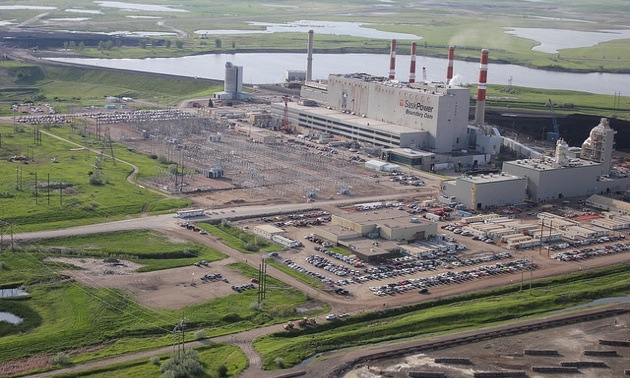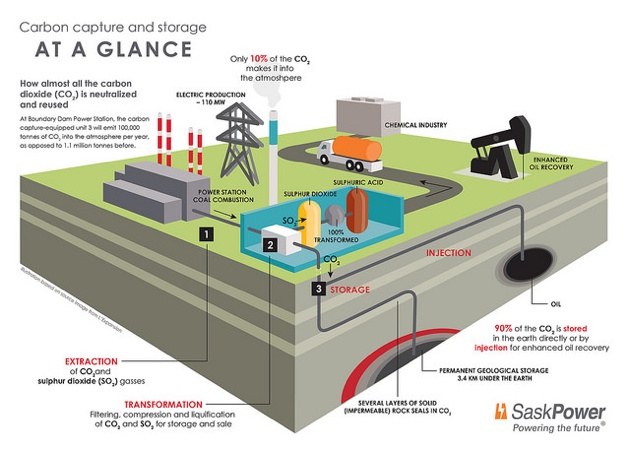SaskPower puts carbon capture technology to the test
Coal-fired units built before 1975 will have to close by 2020

The Boundary Dam Project will capture approximately one million tonnes of CO2 each year. Most of it will be shipped to nearby oil fields for use in enhanced oil recovery operations, where it will be permanently stored underground in oil reservoirs. — Photo courtesy of SaskPower
Power utility companies like Saskatchewan’s SaskPower will have to face some big changes in 2015 when federal regulations come into effect requiring old coal-fired electricity generation plants to shape up or close their doors.
Under the new regulation, coal-fired units built before 1975 will have to close by 2020 and units built after 1975 are required to close by 2030—unless they are equipped with carbon capture and storage technology (CCS).
SaskPower has begun the world’s first implementation of CCS technology at its Boundary Dam Integrated Carbon Capture and Storage Project in Estevan
The project will transform Boundary Dam Power Station’s Unit 3 into a reliable, long-term producer of clean baseload electricity, while enhancing provincial oil production and reducing greenhouse gas emissions.
Carbon capture and storage (CCS) is a process where carbon dioxide (CO2) is captured using a solvent, which first absorbs the sulfphur dioxide (SO2) and then the carbon dioxide. The solvent is then processed through a reclaimer to remove the SO2, then the CO2, using steam. The solvent or amine process is then recycled for more absorption.

CCS infographic indicating the process where CO2 is captured and stored deep underground. — Graphic courtesy of SaskPower
Capture and storage
Robert Watson, SaskPower’s president and CEO, said the CO2 gas is then super-compressed and either stored deep underground at a carefully selected site, or used elsewhere—transported by pipeline or specialized truck—most notably injected into oil fields to boost production.
The SO2 is transformed into sulfuric acid, a tradable commodity that is then sold on the market.
SaskPower can store captured carbon dioxide at its Carbon Storage and Research Centre near Boundary Dam Power Station, or sell the gas to oil companies for what is called enhanced oil recovery.
“These companies take the gas by pipeline and inject it into an aging oil field,” said Watson. “The gas increases pressure and allows the remaining oil to flow more easily.”
The carbon dioxide then binds to the oil and can be recycled again and injected into the oil field. There is no application as of yet for the mining industry.
Typically, the CO2 is transported through a carbonized steel pipeline and stored in stable geological formations that have been carefully selected and match a strict set of criteria. The formations consist of layers of porous rock located deep underground and beneath a layer or multiple layers of non-porous rock. Deep saline formations provide the largest potential area for the storage of CO2, while depleted oil and gas reservoirs have similar properties as saline formations and are also considered secure repositories for CO2.
Boundary Dam
The retrofit of the Boundary Dam power facility makes the unit virtually new, utilizing many components which still have functionality. New components include the world’s first low-temperature turbine, a new generator, new heat recovery systems, new control processes and control room, and a refurbished boiler to make steam.
SaskPower embarked on the ambitious journey to become the world’s first to use CCS because, previous to the upgrade, just under 50 per cent of its power generation capacity came from coal.
“Federal regulations coming into effect in 2015 limit the amount of carbon dioxide that an end-of-life (50-year-old) coal plant can emit,” said Watson. “We had to decide if we could clean up the emissions on coal plants so we could keep affordable coal power in our fleet.”
Coal’s future
The future of coal as an environmentally and economically sustainable fuel for electrical power will be proven by Boundary Dam and other first-mover projects, he added.
“Coal will remain as an electrical fuel for the future, one that is abundant and affordable.
"Advances are being made, but over the past 50 years there has been no significant breakthrough that will allow us to sustainably replace fossil fuel-based power production.
"CCS is a way to reduce the environmental footprint of those fossil fuels,” said Watson.
SaskPower will weigh its options in terms of future CCS retrofits once Boundary Dam commences operation this year.
The power company operates six other coal units at various stages in their usability lives.
“CCS is one of our options,” said Watson. “We believe we are seeing coal’s future role as a fuel for electricity being unveiled.”
Affordable energy
Watson said CCS is the only real alternative to shutting down all end-of-life coal plants, a move that would potentially raise electricity costs dramatically and negate the company’s ability to meet the growing demand for power in Saskatchewan.
He adds it is surprising that other companies and countries are still on the fence about building demonstration CCS projects.
“The prohibitive factor in pursuing these types of projects is lack of conviction and vision to clean up the environment,” he said, “and not technological, and soon to be demonstrated, economic issues.”
SaskPower’s investment in Boundary Dam and its other CCS initiatives aim to be financially responsible in order to keep affordable power flowing to homes.
“They are options we’re exploring to make sure we provide the most reliable service to customers, while reducing our impact on the environment for future generations,” said Watson. “As world governments turn to more strict carbon dioxide regulations, carbon capture and storage will become a necessity.”




